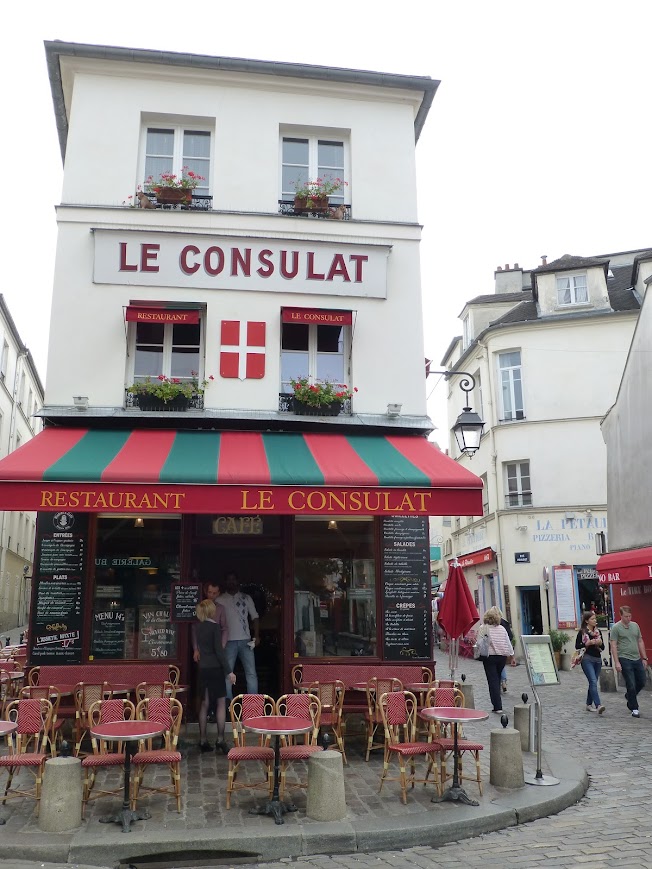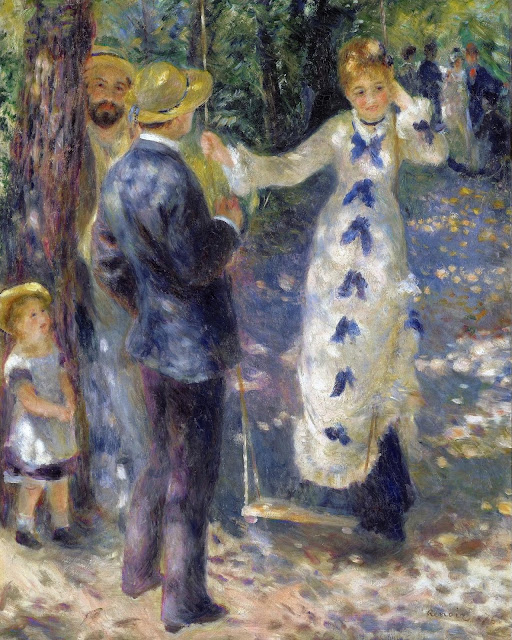Place Emile Goudeau
Au Lapin Agile
'Au Lapin Agile' is a famous Montmartre cabaret. It existed in around 1860, as the 'Au rendez-vous des voleurs' which meant 'Where the Thieves Meet'. Later it became known as the Cabaret des Assassins, with its walls decorated with portraits of famous murderers. According to legend, its name relates to the murder of the owner's son in an attempted robbery by a band of gangsters.
In 1875, the artist Andre Gill painted the sign that suggests its current name (see below). It was a picture of a rabbit jumping out of a saucepan, from which the name Au Lapin Agile evolved, meaning the Nimble Rabbit. The Lapin Agile became the favourite spot for struggling artists and writers, including Picasso, Modigliani, Apollinaire, Roman Greco and Utrillo.

Pablo Picasso's 1905 oil painting, Au Lapin Agile helped to make the cabaret world famous, and undoubtedly added to the reputation of its namesake.
The Lapin Agile operates today largely unchanged and maintains its tradition as an informal cabaret venue. It has also been the inspiration for a 1993 play written by Steve Martin, Picasso at the Lapin Agile, which depicts an imagined meeting between Pablo Picasso and Albert Einstein at the Lapin Agile.
Renoir's La Balancoire (1876)
Musee de Montmartre
Musee de Montmartre includes studios which were once meeting places and home to many artists, including Pierre-August Renoir, Charles Camoin, Raoul Dufy, Emile-Othon Friesz, Emile Bernard, Suzanne Valadon and Maurice Utrillo. Close to the centre of Montmartre, it also has a lovely garden and views over the adjoining vineyard and Paris. The museum is housed in buildings that are three centuries old, the Hotel Demarne and the Maison du Bel Air. The collections of the museum contains paintings, photographs, posters and manuscripts that depict the history and atmosphere of the neighbourhood from the nineteenth and twentieth centuries.
Bal du Moulin de la Galette by Renoir
The Bal du Moulin de la Galette (or Dance at the Moulin de la Galette) by Pierre-Auguste Renoir is one of my favourite paintings at the Musee d'Orsay. It perfectly captures the atmosphere of a time and a place. It was painted by Renoir in 1876 and is an impressionistic depiction of a Sunday afternoon in the Belle Epoque era, at the original Moulin de la Galette in Montmartre. In the late 19th century, this was a place where working class Parisians would dress up and go to dance, drink and eat galettes into the evening.
Sacre Coeur
The Sacre Coeur Basilica is a Roman Catholic Church located at the top of the butte of Montmartre. Its white dome is visible in the distance across Paris, as a beacon of Montmartre. With a dome 200 metres above the Seine, it provides a beautiful panoramic view of Paris and is a magnet for tourists.
View from Montmartre
Le Passe-Muraille or The Walker Through Walls
Le Passe-Muraille is a sculpture in Montmartre based on a character, Monsieur Dutilleul, in Marcel Ayme's 1941 short story, about a man who can walk through walls. Having discovered his special talent, he uses it to secretly visit his married lover. The sculpture, made in bronze, depicts the moment when Dutilleul suddenly loses his power, as he is half way through a wall, attempting to escape from his lover's husband!
The sculpture is located at the junction of Rue Norvins, Rue Girardon, Rue Orchampt and Avenue Junot, close to where the French author lived. Ayme's story has inspired at least 5 cinematic adaptations, and has also been the basis for a 1997 stage musical.
For the perfect photo opportunity, why not grab Monsieur Dutilleul's hand and try to pull him through the wall (his shiny hand is evidence of many unsuccessful attempts!).
Le Consulat, Montmartre
 Located in a prominent position on the cobble stoned rue Norvins, Le Consulat would have to be one of the most photographed cafe's in Montmartre. With typical French food and vintage charm, the cafe boasts a famous artistic clientele from a bygone era, including Picasso, Sisley, Van Gogh, Toulouse-Lautrec and Monet.
Located in a prominent position on the cobble stoned rue Norvins, Le Consulat would have to be one of the most photographed cafe's in Montmartre. With typical French food and vintage charm, the cafe boasts a famous artistic clientele from a bygone era, including Picasso, Sisley, Van Gogh, Toulouse-Lautrec and Monet.
Fete des Vandages, Montmartre
For more than 80 years, the Montmartre Grape Harvest Festival has been celebrating the vineyards and the Montmartre territory. Gastronomic brotherhoods come from all over France and neighbouring countries.
Rue de l'Abreuvoir
View towards Montmartre from the clock at Musee d'Orsay

The clock of the Orsay Museum, a former railway station, provides stunning views over Paris and its surrounds. The clock is an important symbol of both the building's history and Parisian history in general. The elegant design of the clock represents the advanced architecture of the 19th century in Paris.
La Maison Rose, Montmartre
Wall of Love, Montmartre
Rue Cortot, Montmartre
Rue Cortot is a picturesque street in Montmartre. Of the 20 properties on this street, over a dozen of France’s most famous artists have lived there in the late 19th and early 20th century.
Le Clos Montmartre
Le Clos Montmartre or the Vineyard of Montmartre is a hidden gem located not far from the Sacre Coeur in Montmartre. The Vineyard is owned by the City of Paris and was created as part of an attempt to protect a section of Montmartre from real estate developers. The Vineyard is celebrated each year in a grape harvest festival (called La Fete des Vendanges), which attracts about 500,000 people annually. Its location on a sloping plot means that it can be seen from adjacent streets, along with the city landscape. Amazingly, the small plot, of only 0.15 hectares produces 27 varieties of wine and about 1700 bottles of wine
Moulin Rouge
The Moulin Rouge was founded in 1889 and is best known as the birthplace of the modern form of the can-can dance. When it first opened it was an outdoor garden cafe-concert, which aimed to cater for the very rich, allowing them to 'slum' it in a fashionable district. It was an extravagant setting with gigantic elephant's adorning the garden. It provided a place for all walks of life to mix, including workers, local residents, artists, business men, elegant women and foreigners.
















